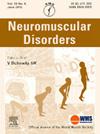Motor function testing rates and outcomes in Duchenne muscular dystrophy with comorbid autism and attention-deficit/hyperactivity disorder
IF 2.7
4区 医学
Q2 CLINICAL NEUROLOGY
引用次数: 0
Abstract
Patients with Duchenne muscular dystrophy have a higher incidence of neurodevelopmental disorders, particularly autism spectrum and attention-deficit/hyperactivity disorders, than the general population. However, the clinical outcome assessments used in the evaluation of patients with Duchenne and as endpoints in clinical trials require significant patient cooperation, which can be challenging in those with severe behavioral issues and leads to their exclusion. With ongoing expansion of the therapeutic arsenal, we aimed to explore differences in motor function test completion and measurements between Duchenne patients with and without autism spectrum disorder or attention-deficit/hyperactivity disorder in a large tertiary care hospital's pediatric neuromuscular clinic. We identified significantly lower rates of motor function testing and motor function test scores among Duchenne patients with autism or attention-deficit/hyperactivity disorder. These findings underscore the need for adequate opportunity to complete motor function testing in those patients. Alternatively, the Duchenne community could consider validating more patient-reported outcomes and wearable device outcome measures in trials that families of children with neurodevelopmental disorders could more easily use. These interventions would improve equitable access to new therapies for patients with severe behavioral issues and allow researchers to track broader clinical outcomes among all patients as the Duchenne treatment landscape expands.
杜氏肌营养不良合并自闭症和注意缺陷/多动障碍的运动功能测试率和结果
与一般人群相比,杜氏肌营养不良患者有更高的神经发育障碍发生率,特别是自闭症谱系和注意力缺陷/多动障碍。然而,用于评估Duchenne患者的临床结果评估和作为临床试验终点的临床结果评估需要大量的患者合作,这对于那些有严重行为问题的患者来说可能是具有挑战性的,并导致他们被排除在外。随着治疗手段的不断扩大,我们的目的是探讨在一家大型三级护理医院的儿童神经肌肉诊所中,患有和不患有自闭症谱系障碍或注意缺陷/多动障碍的Duchenne患者的运动功能测试完成情况和测量结果的差异。我们发现患有自闭症或注意缺陷/多动障碍的杜氏症患者的运动功能测试率和运动功能测试分数明显较低。这些发现强调了在这些患者中需要有足够的机会完成运动功能测试。另外,Duchenne社区可以考虑在试验中验证更多患者报告的结果和可穿戴设备的结果测量,这样神经发育障碍儿童的家庭可以更容易地使用。这些干预措施将改善严重行为问题患者获得新疗法的公平途径,并允许研究人员在所有患者中追踪更广泛的临床结果,因为Duchenne治疗领域正在扩大。
本文章由计算机程序翻译,如有差异,请以英文原文为准。
求助全文
约1分钟内获得全文
求助全文
来源期刊

Neuromuscular Disorders
医学-临床神经学
CiteScore
4.60
自引率
3.60%
发文量
543
审稿时长
53 days
期刊介绍:
This international, multidisciplinary journal covers all aspects of neuromuscular disorders in childhood and adult life (including the muscular dystrophies, spinal muscular atrophies, hereditary neuropathies, congenital myopathies, myasthenias, myotonic syndromes, metabolic myopathies and inflammatory myopathies).
The Editors welcome original articles from all areas of the field:
• Clinical aspects, such as new clinical entities, case studies of interest, treatment, management and rehabilitation (including biomechanics, orthotic design and surgery).
• Basic scientific studies of relevance to the clinical syndromes, including advances in the fields of molecular biology and genetics.
• Studies of animal models relevant to the human diseases.
The journal is aimed at a wide range of clinicians, pathologists, associated paramedical professionals and clinical and basic scientists with an interest in the study of neuromuscular disorders.
 求助内容:
求助内容: 应助结果提醒方式:
应助结果提醒方式:


